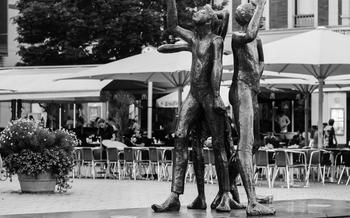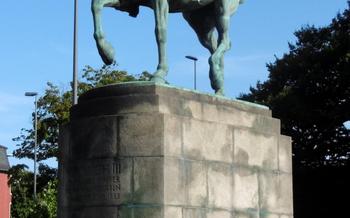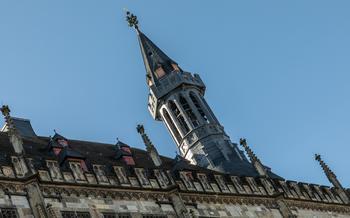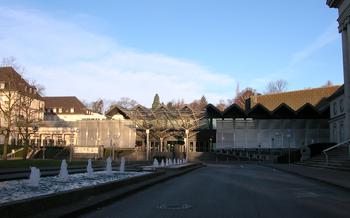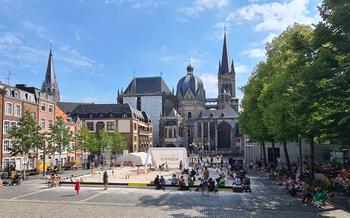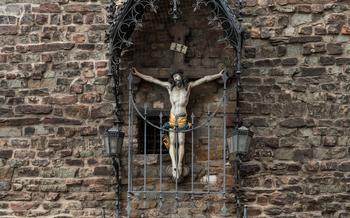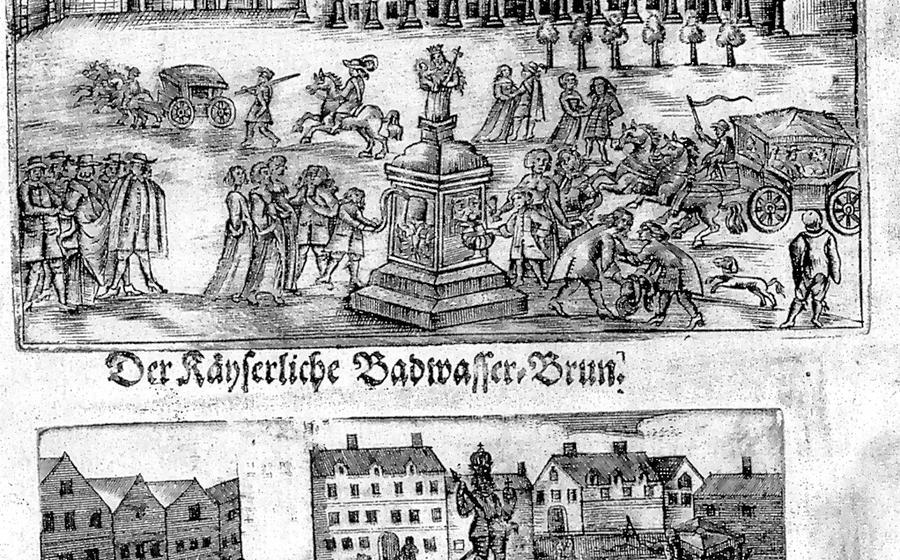
Kaiserbrunnen
- Historical Significance
- Location and Surroundings
- Legends and Symbolism
- The Eagle Statue
- The Emperor Charlemagne
- The Aachen Cathedral:
- The Market Square (Marktplatz)
- The Coronation Route
- Visiting the Kaiserbrunnen
- Exploring Aachen's Old Town:
- Aachen's Thermal Baths: A Relaxing Retreat
- The Suermondt-Ludwig-Museum
- The International Charlemagne Prize
- Insider Tip: Unveiling Aachen's Hidden Gems
Historical Significance
The history of the Kaiserbrunnen is deeply intertwined with the development of Aachen and its significance throughout European history. Its origins can be traced back to antiquity, where it served as a water source for the Roman settlement known as Aquae Granni. During the Roman Empire, the fountain was a vital part of the city's infrastructure, supplying clean water to its inhabitants.
In the era of Charlemagne, the Kaiserbrunnen gained even greater prominence. Charlemagne, who was crowned Emperor of the Holy Roman Empire in Aachen Cathedral in 800 AD, is believed to have had a special affinity for the fountain. Legend has it that he would often sit by the fountain, contemplating matters of state and seeking inspiration.
The coronation of Charlemagne marked the beginning of a tradition that would continue for centuries. Aachen became the traditional coronation city of the Holy Roman Empire, and the Kaiserbrunnen played a central role in the coronation processions. Newly elected emperors would pass by the fountain, acknowledging its symbolic importance and paying homage to Charlemagne's legacy.
During the Holy Roman Empire, the Kaiserbrunnen continued to be a significant landmark, representing the imperial authority and the enduring legacy of Charlemagne. It stood as a testament to the city's imperial past and its role as a center of power and prestige.
Location and Surroundings
The Kaiserbrunnen occupies a central position in Aachen's Market Square, also known as Marktplatz, the heart of the city's old town. This vibrant square is a bustling hub of activity, surrounded by historic buildings, shops, restaurants, and cafes. The fountain stands in close proximity to the majestic Aachen Cathedral, a UNESCO World Heritage Site and a symbol of the city's rich religious and cultural history. Other notable landmarks in the vicinity include the Town Hall, with its intricate Gothic architecture, and the Elisenbrunnen, another historic fountain with its own unique charm. The Kaiserbrunnen's integration with these architectural gems creates a harmonious ensemble that transports visitors back in time.
Legends and Symbolism
The Kaiserbrunnen is steeped in legends and symbolism, adding to its cultural significance in local folklore. One of the most enduring myths is that the fountain possesses healing powers. It is said that drinking water from the fountain can cure various ailments, and many visitors make a point of doing so.
The fountain's association with Charlemagne also contributes to its symbolic importance. Charlemagne, who was crowned emperor in Aachen Cathedral in 800 AD, is a revered figure in the city's history. The fountain is seen as a symbol of his reign and the power and prestige of the Holy Roman Empire.
The imperial eagle perched atop the fountain is another potent symbol. The eagle, a symbol of strength and majesty, represents the Holy Roman Empire's authority and dominion over a vast territory. The intricate carvings and sculptures on the fountain further enhance its symbolism, depicting scenes from the Bible and the lives of saints, reinforcing the religious and cultural significance of the fountain.
The Eagle Statue
The Kaiserbrunnen is majestically crowned by a splendid bronze eagle, its wings outstretched as if embracing the city. This awe-inspiring sculpture serves as an embodiment of the Holy Roman Empire, a symbol of imperial power and authority. The intricate details and masterful craftsmanship of the eagle are a testament to the artistic prowess of its creators. The piercing gaze of the eagle, with its sharp talons gripping the orb and scepter, conveys a sense of strength and sovereignty. Throughout history, the eagle has been a recurring motif in heraldry and iconography, representing courage, nobility, and dominion. In Aachen, the eagle atop the Kaiserbrunnen stands as a proud symbol of the city's rich imperial heritage and its enduring connection to the legacy of Charlemagne.
The Emperor Charlemagne
Charlemagne, also known as Charles the Great, holds a significant connection to the Kaiserbrunnen and the city of Aachen. In 794 AD, he was crowned as the King of the Franks in Aachen Cathedral. This event marked the beginning of the Carolingian dynasty and the rise of Aachen as a prominent center of power in the Frankish Empire.
Charlemagne's reign was characterized by military conquests, cultural advancements, and the consolidation of Christian influence across Europe. He expanded the empire's borders, uniting much of Western Europe under his rule. Charlemagne was a patron of the arts and education, establishing schools and libraries throughout his empire. His court in Aachen attracted scholars, artists, and intellectuals from various parts of Europe.
Charlemagne's association with the Kaiserbrunnen is rooted in the tradition of imperial coronations. The fountain served as a symbolic landmark during coronation processions, with newly elected emperors passing by it on their way to Aachen Cathedral. Charlemagne's legacy remains deeply intertwined with the city of Aachen and the Kaiserbrunnen, which stands as a testament to his reign and the profound impact he had on European history.
The Aachen Cathedral:
Just steps away from the Kaiserbrunnen stands the magnificent Aachen Cathedral, a masterpiece of Gothic architecture that has earned its place as a UNESCO World Heritage Site. Its towering spires and intricate stone carvings create a breathtaking sight. Inside, visitors are awed by the soaring vaults, stained glass windows, and elaborate altars. The cathedral holds immense religious and cultural significance, serving as the coronation church for German emperors and a symbol of Aachen's rich history. Its proximity to the Kaiserbrunnen further enhances the allure of this historic square, making it a must-visit destination for anyone exploring Aachen's architectural wonders.
The Market Square (Marktplatz)
The Kaiserbrunnen proudly stands in the heart of Aachen's vibrant Market Square (Marktplatz), a bustling hub of activity and historical charm. Surrounded by a kaleidoscope of historic buildings, shops, restaurants, and cafes, the square pulsates with life and energy. The Marktbrunnen, with its iconic bronze eagle, becomes the focal point of this lively scene, a symbol of the city's rich history and cultural heritage.
The Marktplatz has been the heart of Aachen's old town for centuries, a place where people gather to trade, socialize, and celebrate. The square is adorned with a tapestry of historic buildings, each with its own unique story to tell. The majestic Aachen Cathedral, with its towering Gothic spires, stands as a testament to the city's religious and cultural significance. The 14th-century Rathaus (Town Hall), with its intricate facade and beautiful courtyard, adds to the square's architectural grandeur.
A visit to the Marktplatz offers a glimpse into Aachen's rich culinary scene. From traditional German fare to international delicacies, there's something to satisfy every palate. Cafes and restaurants line the square, inviting visitors to linger over a cup of coffee, indulge in a hearty meal, or simply soak up the lively atmosphere.
During the festive season, the Marktplatz transforms into a magical winter wonderland, hosting one of Germany's most renowned Christmas markets. The square twinkles with festive lights, and the air fills with the scent of mulled wine and roasted chestnuts. Stalls selling handcrafted gifts, decorations, and local delicacies line the square, creating a truly enchanting atmosphere.
The Coronation Route
The Kaiserbrunnen played a pivotal role in the coronation processions of the Holy Roman Empire. Newly elected emperors would embark on a ceremonial journey through Aachen, known as the Coronation Route, which culminated at the Aachen Cathedral. The procession would pause at the Kaiserbrunnen, where the emperor would receive blessings and prayers from the clergy. This tradition symbolized the deep connection between the monarchy and the city of Aachen, emphasizing the divine nature of the emperor's authority.
The Coronation Route served as a powerful reminder of Aachen's imperial heritage and its significance as the birthplace of the Holy Roman Empire. The tradition continued for centuries, attracting dignitaries and pilgrims from across Europe. Today, the route remains a significant cultural heritage site, offering visitors a glimpse into the grandeur and pageantry of the medieval imperial coronations.
Visiting the Kaiserbrunnen
The Kaiserbrunnen stands majestically in Aachen's Marktplatz, inviting visitors to explore its rich history and intricate details. Accessibility is excellent, with the fountain open to the public throughout the day. Guided tours are available for those seeking a deeper understanding of the fountain's significance, while self-exploration allows visitors to wander at their own pace, capturing the fountain's beauty from different angles.
Photography enthusiasts will find ample opportunities to document the fountain's grandeur. The intricate carvings, the majestic eagle, and the surrounding historic buildings provide a picturesque backdrop for capturing memories of your visit. However, it is essential to respect the fountain's historic significance and refrain from touching or climbing on it.
Whether you choose to join a guided tour or explore independently, the Kaiserbrunnen is a must-see attraction in Aachen. Its captivating history, architectural beauty, and cultural symbolism make it a cherished landmark that continues to inspire and captivate visitors from around the world.
Exploring Aachen's Old Town:
Beyond the Kaiserbrunnen, Aachen's old town unveils a captivating tapestry of history and charm. Stroll along the intricate web of narrow cobblestone streets, lined with beautifully preserved historic buildings, each with a unique tale to tell. Admire the architectural wonders, from Gothic churches to Renaissance townhouses, that showcase the city's rich past.
Discover hidden courtyards, where time seems to stand still, and uncover delightful boutiques, art galleries, and charming cafes nestled amidst the ancient walls. Indulge in a leisurely shopping spree, finding one-of-a-kind treasures and local handicrafts. Take a break at one of the many inviting restaurants, savoring the delectable flavors of traditional German cuisine and local specialties.
As dusk descends, the old town transforms into a vibrant hub of activity, with lively bars, pubs, and music venues coming to life. Experience the infectious energy as locals and visitors alike gather to unwind, socialize, and enjoy the vibrant atmosphere. Whether you seek cultural immersion, culinary delights, or simply the chance to soak in the charm of a bygone era, Aachen's old town promises an unforgettable journey through time.
Aachen's Thermal Baths: A Relaxing Retreat
Aachen is renowned for its natural hot springs, which have been a source of relaxation and rejuvenation for centuries. Visitors can immerse themselves in the warm, mineral-rich waters of the city's many thermal baths, experiencing the healing properties that have made Aachen a popular spa destination since Roman times.
The Carolus Thermen, located in the heart of the city, offers a modern and luxurious bathing experience. With its elegant architecture, spacious pools, and state-of-the-art wellness facilities, the Carolus Thermen provides a tranquil oasis for those seeking relaxation and rejuvenation.
For a more traditional experience, visitors can head to the Thermalbad Quellenhof, which has been welcoming guests since the 19th century. This historic bathhouse features a variety of thermal pools, as well as a sauna, steam room, and massage treatments.
Whether you choose the modern Carolus Thermen or the historic Thermalbad Quellenhof, Aachen's thermal baths offer a unique and revitalizing experience that is not to be missed.
The Suermondt-Ludwig-Museum
Adding to Aachen's rich cultural tapestry, the Suermondt-Ludwig-Museum stands as a testament to the city's artistic heritage. Within its walls, a treasure trove of art from the Middle Ages to the 20th century awaits discovery. Paintings, sculptures, and decorative arts come together, narrating the evolution of artistic expression across eras.
A particular focus of the museum lies in showcasing local and regional talents, providing a platform for the city's artistic legacy to shine. Through the works of these masters, visitors gain a deeper understanding of Aachen's cultural identity and its contributions to the broader art world.
The Suermondt-Ludwig-Museum not only houses a diverse collection but also serves as a hub for cultural events and exhibitions. Temporary displays, workshops, and lectures breathe life into the museum's galleries, fostering a vibrant dialogue between art, history, and the community.
Whether you're an art enthusiast, a history buff, or simply seeking a moment of inspiration, the Suermondt-Ludwig-Museum offers a journey through time and creativity, immersing you in the rich artistic tapestry of Aachen.
The International Charlemagne Prize
The Kaiserbrunnen has played a significant role in the prestigious International Charlemagne Prize, awarded annually in Aachen since 1950. This prize honors individuals who have made exceptional contributions to European unity and integration. The award ceremony takes place in Aachen's historic Rathaus (City Hall), located just steps away from the Kaiserbrunnen.
The prize ceremony is a grand event that attracts dignitaries, politicians, and cultural figures from across Europe. The recipient of the award is celebrated for their efforts in fostering peace, cooperation, and understanding among European nations. The Kaiserbrunnen, with its symbolic representation of Charlemagne's legacy, serves as a fitting backdrop for this prestigious event.
Aachen's hosting of the International Charlemagne Prize further underscores the city's profound connection to European history and its enduring commitment to unity and cooperation. The award ceremony held near the Kaiserbrunnen not only honors Charlemagne's legacy but also celebrates the spirit of European integration and the ongoing pursuit of a united and peaceful Europe.
Insider Tip: Unveiling Aachen's Hidden Gems
For an unforgettable Aachen experience, venture beyond the Kaiserbrunnen to explore the city's other hidden gems. Immerse yourself in the magic of the Aachen Christmas Market, where the air is filled with festive cheer and the aroma of mulled wine. Discover the Elisenbrunnen, another historic fountain with its own unique charm. Satisfy your taste buds with local delicacies like Printen gingerbread, a sweet treat that embodies Aachen's culinary heritage. And if you have time, embark on a journey into the picturesque surrounding countryside, dotted with enchanting castles and breathtaking landscapes. These insider tips will unlock a deeper connection to Aachen's rich history and vibrant culture, leaving you with lasting memories of your visit.

